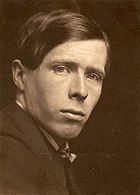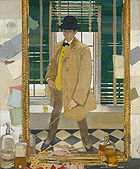
William Orpen
Encyclopedia

Order of the British Empire
The Most Excellent Order of the British Empire is an order of chivalry established on 4 June 1917 by George V of the United Kingdom. The Order comprises five classes in civil and military divisions...
, RA
Royal Academy
The Royal Academy of Arts is an art institution based in Burlington House on Piccadilly, London. The Royal Academy of Arts has a unique position in being an independent, privately funded institution led by eminent artists and architects whose purpose is to promote the creation, enjoyment and...
, RHA
Royal Hibernian Academy
The Royal Hibernian Academy is an artist-based and artist-oriented institution in Ireland, founded in Dublin in 1823.-History:The RHA was founded as the result of 30 Irish artists petitioning the government for a charter of incorporation...
(27 November 1878 – 29 September 1931) was an Irish portrait painter, who worked mainly in London. He was also a war artist
War artist
A war artist depicts some aspect of war through art; this might be a pictorial record or it might commemorate how "war shapes lives." War artists have explored a visual and sensory dimension of war which is often absent in written histories or other accounts of warfare.- Definition and context:A...
.
Life and work

Stillorgan
Stillorgan , formerly a village in its own right, is now a suburban area of Dublin in Ireland. Stillorgan is located in Dun Laoghaire-Rathdown County, and contains many housing estates, shops and other facilities, with the old village centre still present...
, County Dublin
County Dublin
County Dublin is a county in Ireland. It is part of the Dublin Region and is also located in the province of Leinster. It is named after the city of Dublin which is the capital of Ireland. County Dublin was one of the first of the parts of Ireland to be shired by King John of England following the...
, Orpen was a fine draughtsman and a popular painter of the well-to-do in the period leading up to World War I
World War I
World War I , which was predominantly called the World War or the Great War from its occurrence until 1939, and the First World War or World War I thereafter, was a major war centred in Europe that began on 28 July 1914 and lasted until 11 November 1918...
.
He was involved in the "Celtic revival
Celtic Revival
Celtic Revival covers a variety of movements and trends, mostly in the 19th and 20th centuries, which drew on the traditions of Celtic literature and Celtic art, or in fact more often what art historians call Insular art...
" in Ireland and took part in the attempt there to find a visual counterpart to the birth of new national literary language (McConkey 2005). Although his studio was in London, he spent time in Ireland painting, he was a friend of Hugh Lane
Hugh Lane
Sir Hugh Percy Lane is best known for establishing Dublin's Municipal Gallery of Modern Art and for his remarkable contribution to the visual arts in Ireland...
and influenced the Irish realist painters, like Sean Keating
Seán Keating
Seán Keating was an Irish romantic-realist painter who painted some iconic images of the Irish War of Independence and of the early industrialization of Ireland...
, who were beginning their careers at that time.
Orpen's wife was Grace Knewstub, whom he married in 1901 and with whom he had three daughters. The marriage was not happy, and the painter eventually ran off with one of his sitters, Madame Saint-George, a wealthy young married woman whom he painted around 1912.
Like Sir John Lavery
John Lavery
Sir John Lavery was an Irish painter best known for his portraits.Belfast-born John Lavery attended the Haldane Academy, in Glasgow, in the 1870s and the Académie Julian in Paris in the early 1880s. He returned to Glasgow and was associated with the Glasgow School...
, Orpen was an official war painter of the First World War. In 1917 he travelled to the Western Front
Western Front (World War I)
Following the outbreak of World War I in 1914, the German Army opened the Western Front by first invading Luxembourg and Belgium, then gaining military control of important industrial regions in France. The tide of the advance was dramatically turned with the Battle of the Marne...
and produced drawings and paintings of privates, dead soldiers and German prisoners of war along with official portraits of generals and politicians. His large paintings of the Versaille Peace Conference captured the political wranglings and the vainglory of the gathered politicians and statesmen, whom Orpen came to loathe but relied upon for post-war commissions. Most of these works, 138 in all, he gave to the British government on the understanding that they should be framed in simple white frames and kept together as a single body of work. They are now in the collection of the Imperial War Museum
Imperial War Museum
Imperial War Museum is a British national museum organisation with branches at five locations in England, three of which are in London. The museum was founded during the First World War in 1917 and intended as a record of the war effort and sacrifice of Britain and her Empire...
in London. For his war work, he was made a Knight Commander of the Order of the British Empire
Order of the British Empire
The Most Excellent Order of the British Empire is an order of chivalry established on 4 June 1917 by George V of the United Kingdom. The Order comprises five classes in civil and military divisions...
(KBE) in the 1918 King's birthday honours list. He was elected a Royal Academician (member of the Royal Academy of Arts
Royal Academy
The Royal Academy of Arts is an art institution based in Burlington House on Piccadilly, London. The Royal Academy of Arts has a unique position in being an independent, privately funded institution led by eminent artists and architects whose purpose is to promote the creation, enjoyment and...
) in 1919.
He was deeply affected by the suffering he witnessed in the war and his To the Unknown British Soldier Killed in France first exhibited in 1923 showed a flag draped coffin flanked by a pair of ghostly and wretched soldiers clothed only in tattered blankets. Although widely admired by the public, this picture was attacked by the press and Orpen painted out the soldiers before the painting, which had originally been dedicated to Field Marshal Haig, was accepted by the Imperial War Museum in 1927.
According to Bruce Arnold, writing in Irish Art a Concise History:
- ... while at times his portraits are rather shallow, he was capable of excellent and sympathetic work, particularly in family and group portraits."
As noted by his biographer, H. L. Wellington, in referring to the portrait of Lily Carstairs which formed part of the Royal Academy Exhibition of 1915,
- Orpen was fond of painting women sitters against a black background, lighting the figure from two sides, an arrangement which gave luminosity and a certain ethereal appearance to his unfaltering but matter of fact statement…
Bruce Arnold
Bruce Arnold
Bruce Arnold is an American jazz guitarist, composer, educator and author residing in New York City. His explorations into the applications of 20th century classical theory in contemporary forms such as rock and jazz has created a unique compositional and improvisational sound...
noted Orpen's interest in self-portraiture: his self-portraits are often searching and dramatic. In his The Dead Ptarmigan - a self-portrait in the National Gallery of Ireland
National Gallery of Ireland
The National Gallery of Ireland houses the Irish national collection of Irish and European art. It is located in the centre of Dublin with one entrance on Merrion Square, beside Leinster House, and another on Clare Street. It was founded in 1854 and opened its doors ten years later...
, he scowls from the frame while holding a dead ptarmigan at head height.
In a review of an Orpen exhibition at the Imperial War Museum
Imperial War Museum
Imperial War Museum is a British national museum organisation with branches at five locations in England, three of which are in London. The museum was founded during the First World War in 1917 and intended as a record of the war effort and sacrifice of Britain and her Empire...
in London in 2005, Kenneth McConkey attributes this shallowness of Orpen's portraits to emotional exhaustion, resulting from his experience as a painter of war. He writes of Orpen's post-war activity:
- Now the portraits were done with mechanical efficiency, and without pause for reflection, save when he scrutinised himself and found a face he could no longer understand. his face... grimaces, it squints, it scowls; in the 1920s it papers over the inner turmoil left by the long pathetic queues of gas-blinded tommies.
Orpen died aged 53 in London, and was buried at Putney Vale Cemetery
Putney Vale Cemetery
Putney Vale Cemetery and Crematorium in London is surrounded by Wimbledon Common and Richmond Park, and is located within forty-seven acres of parkland. The cemetery was opened in 1891 and the crematorium in 1938...
. A stone tablet in the Island of Ireland Peace Park
Island of Ireland Peace Park
The Island of Ireland Peace Park and its surrounding park , also called the Irish Peace Park or Irish Peace Tower in Messines, near Ypres in Flanders, Belgium, is a war memorial to the soldiers of the island of Ireland who died, were wounded or are missing from World War I, during Ireland's...
Memorial, Messines, Belgium, commemorates him.
On 9 May 2010, a painting of Orpen's mistress Yvonne Aubicque featured on BBC1's "Antiques Roadshow
Antiques Roadshow
Antiques Roadshow is a British television show in which antiques appraisers travel to various regions of the United Kingdom to appraise antiques brought in by local people. It has been running since 1979...
". The owner believed it to be a copy of an original in the Imperial War Museum
Imperial War Museum
Imperial War Museum is a British national museum organisation with branches at five locations in England, three of which are in London. The museum was founded during the First World War in 1917 and intended as a record of the war effort and sacrifice of Britain and her Empire...
- however it turned out to be a "copy" painted by Orpen himself and estimated to be worth £250,000.
Writings
- The Outline of Art.
- An Onlooker in France (1917–1919).
- Stories of Old Ireland and Myself.'

